My Re-Housed DIY Maestro Boomerang Wah Pedal
Last updated 10/1/06
By Paul Marossy
Having some very good success with my second DIY wah project in all respects, I thought it would be appropriate to place my Maestro Boomerang clone in a real wah shell since I like it so much and move the Colorsound Wah circuit from my first DIY wah project into the shell of my second project. With a little bit of planning, it is very simple to take the guts out of an existing wah and replace it with your own circuit. Here's how I made my own "custom" wah pedal.
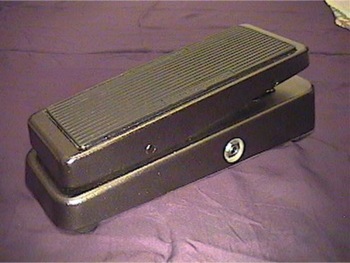 |
The shell is from a Dunlop Cry Baby which I purchased off of ebay for $20. I masked off the pedal and painted it a kind of metallic dark chocolate brown color. It looks really nice in real life. |
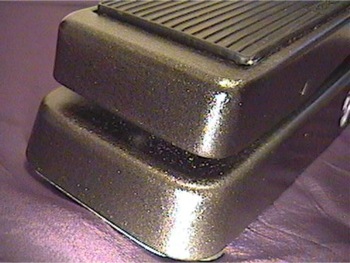 |
This shows the paint a little bit better. It's still not true to life, but it gives you the basic idea. |
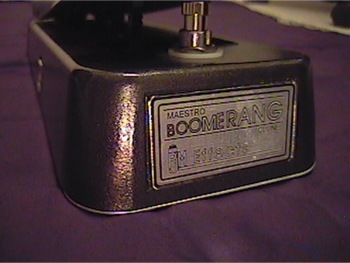 |
I made my own nameplate to give it that custom look. The graphics were made with my ever useful AutoCAD program. |
 |
This is a better view of the nameplate. This was made using my usual stickyback method and is applied to a piece of aluminum tape. |
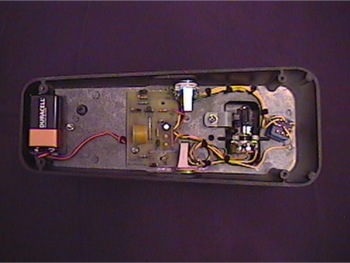 |
This is the interior. When I built the circuit initially, I was thinking ahead to the possibility of it going in a real wah shell in the future. It worked out pretty well for "off the cuff engineering". The inductor just barely fits when the bottom cover is on. |
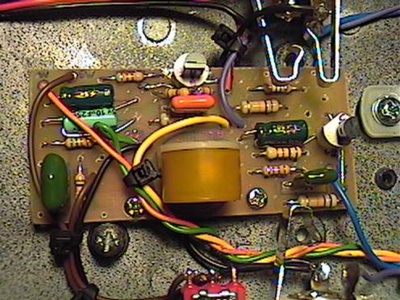 |
About a year after I was done with this project, I etched a new PCB which is a copy of the original BG-2 Boomerang PCB. While I was at it, I added a power jack and a switch on the side to allow for switching between volume and wah modes (neither are shown in this picture). It fits rather nicely in the CryBaby shell. |
 |
The PCB mounts to the shell in the same manner as the real Boomerang - with spacers and two small screws. I also used transistor sockets on this PCB, which required a little bit of modification to use with this PCB. |
If you are reading this, you may be wondering why I didn't just buy a real Boomerang off of ebay. The answer to that question
is that when I initially built the circuit, it was just to see what it sounded like. After playing it for a while, I liked it
so much that I wanted to put it in something more permanent. A side benefit is that the project cost me a total of about $50.
This is far less than what you would pay for a real one - maybe 30% as much, and it's in a sleeker looking enclosure, too.
I honestly don't know how mine sounds compared to the real thing, but it sure sounds good with the reissue yellow Fasel
inductor. After playing this for a while, it appears that the 2N5089 transistors may have slightly too much gain for clean
wah sounds, but it does sound great with distortion! I tried out some MPSA18s in it to see if that would get a little better clean sound, and it seems to be perfect, with an unexpected
side benefit - it actually sounds more vocal now as well. I suspect that this has to do with the Hfe characteristics of the transistors. 2N5089s usually have an Hfe of around 600-800 or higher. The MPSA18s on the other hand have an Hfe of around 400-500. The
lower gain transistors seem to be the better choice for this circuit. A few changes I made also contribute to the sound somewhat. I used
1uF tantalum caps at the output instead of electrolytic caps, added a 4.7uF cap across the power
supply and a 100K trimpot on the emitter of Q2 instead of an 8.2K resistor. With the MPSA18s in the circuit, an 8.2K resistor
makes the Q2 gain too high, and this makes for a lot more hiss and a shrieking oscillation at the
most extreme possible treble setting right before switching off. An 82K resistor is a little too big because it seems to make
the wah sound a little less vocal. With the trimpot set at 47K, it seems to be perfect - a nice vocal sound, minimal hiss and
no oscillations whatsoever. This drops the measured voltage at the emitter of Q2 to about 1.2 volts less than the voltage seen at
the collector of Q2. Some 2N3904s may be closer to the transistors originally used in the circuit than what I chose to use, but will not
be as quiet since they are general purpose transistors and are not designed specifically for audio applications/low noise.
Update 11/20/05: For clean wah sounds, the MPSA18 transistors still had too much gain as some distortion
would occur, especially with a humbucking pickup. I can find no data on the transistors originally
used in the Boomerang, but I am guessing that they are general purpose transistors with an Hfe of
around 200-250. I had some 2N3569s lying around that were within that range, and those work better still. Noise levels
do not appear to be affected by the change. It also sounds a little more vocal with the lower gain
transistors. I also replaced the Alpha 25K pot with a 100K Hot-Potz II. To make the new pot a 25K pot,
I soldered a 33K resistor across the "CW" & "CCW" terminals, which measures almost exactly 25K. I think this pot
may be a little more well suited for use with this circuit, and it really helps it to have a more
vocal sounding quality to it. Now I would say this is the best wah that I have ever heard (in my subjective opinion).
Update 12/26/05: I still wasn't completely satisfied with the 2N3569 transistors, so I decided to try some
BC109s with an Hfe of around 400, and now I am finally totally happy with it. It actually sounds a little
more vocal with these transistors, to my surprise.
Update 9/30/05: I just realized that the schematic that I built my original Boomerang clone from had a mistake on it - the feedback resistor on the second transistor is labeled as a 620K, but I have verified from looking at a real Boomerang wah pedal that it is actually an 820K resistor. Using a 620K resistor here increases the noise floor quite a bit. With the 820K resistor and some BC109 transistors, it sounds just about exactly the same as my 1972 Maestro Boomerang. It took a while, but I finally got it to sound like it's supposed to, and it solves the mystery of why my first build was so noisy, comparatively speaking.
Original Maestro Boomerang PCB Layout (BG-2)